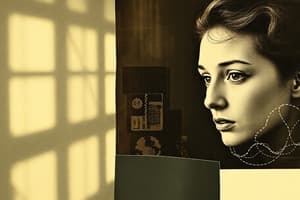Podcast
Questions and Answers
What is the primary purpose of using an inquiry process to investigate the laws of reflection using plane and curved mirrors?
What is the primary purpose of using an inquiry process to investigate the laws of reflection using plane and curved mirrors?
- To predict the qualitative characteristics of images formed by plane and curved mirrors
- To understand the concepts of refraction and the electromagnetic spectrum
- To draw ray diagrams to summarize the findings from the investigation (correct)
- To determine the location, orientation, and size of images formed by plane and curved mirrors
Which of the following is NOT a type of light emission?
Which of the following is NOT a type of light emission?
- Electroluminescence (correct)
- Chemiluminescence
- Bioluminescence
- Triboluminescence
What is the primary purpose of using an inquiry process to investigate the refraction of light as it passes through media of different refractive indices?
What is the primary purpose of using an inquiry process to investigate the refraction of light as it passes through media of different refractive indices?
- To explain the conditions required for partial reflection/refraction and total internal reflection in lenses
- To analyze data and identify trends in how the angle of refraction changes as the angle of incidence increases (correct)
- To determine the velocity of light as it passes through various media
- To describe the properties of light and explain naturally occurring optical phenomena
Which of the following statements best describes the purpose of using algebraic equations and ray diagrams when describing the characteristics and positions of images formed by plane and curved mirrors?
Which of the following statements best describes the purpose of using algebraic equations and ray diagrams when describing the characteristics and positions of images formed by plane and curved mirrors?
Which of the following is a primary focus of the content related to the refraction of light?
Which of the following is a primary focus of the content related to the refraction of light?
What is the main purpose of the content related to the visible and invisible regions of the electromagnetic spectrum?
What is the main purpose of the content related to the visible and invisible regions of the electromagnetic spectrum?
What does Snell's law of reflection state?
What does Snell's law of reflection state?
In a convex mirror, where is the image formed according to ray diagram rules?
In a convex mirror, where is the image formed according to ray diagram rules?
What differentiates a concave mirror used as a converging lens from one used as a diverging lens?
What differentiates a concave mirror used as a converging lens from one used as a diverging lens?
Why are ray diagrams important in understanding how light interacts with mirrors?
Why are ray diagrams important in understanding how light interacts with mirrors?
What characteristic of incident and reflected rays do the ray diagram rules for plane mirrors emphasize?
What characteristic of incident and reflected rays do the ray diagram rules for plane mirrors emphasize?
How are magnification properties of images formed in convex mirrors affected by changes in curvature?
How are magnification properties of images formed in convex mirrors affected by changes in curvature?
According to the laws of reflection, what happens when a ray of light strikes a plane mirror?
According to the laws of reflection, what happens when a ray of light strikes a plane mirror?
What is the primary purpose of drawing ray diagrams for curved mirrors?
What is the primary purpose of drawing ray diagrams for curved mirrors?
Which of the following is the first step in drawing a ray diagram for a curved mirror?
Which of the following is the first step in drawing a ray diagram for a curved mirror?
What is the purpose of the line of sight principle when drawing ray diagrams for curved mirrors?
What is the purpose of the line of sight principle when drawing ray diagrams for curved mirrors?
Which of the following is NOT a characteristic of the image that can be determined from a ray diagram for a curved mirror?
Which of the following is NOT a characteristic of the image that can be determined from a ray diagram for a curved mirror?
What is the significance of the center of curvature in the behavior of concave mirrors?
What is the significance of the center of curvature in the behavior of concave mirrors?




